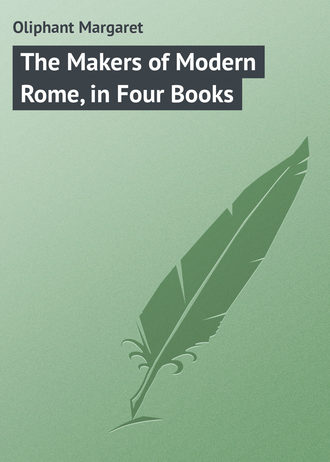
Маргарет Олифант
The Makers of Modern Rome, in Four Books
Paul II. died in August 1471. Another order of man now succeeded these remarkable personages, the first of the line of purely secular princes, men of the world, splendid, unprincipled, and more or less vicious, although in this case it is once more a peasant, without so much as a surname, Sixtus IV., who takes his place in the scene, and who has left his name more conspicuously than any of his predecessors upon the later records of Rome. So far as the reader is concerned, the inscription at the end of the life of Pope Paul is a more melancholy one than anything that concerns that Pope. "Fin qui, scrisse il Platina," says the legend. We miss in the after-records his individual touch, the hand of the contemporary, in which the frankness of the chronicler is modified by the experience and knowledge of an educated mind. The work of Panvinio, scriba del Senato e popolo Romano, who completes the record, is without the same charm.
We have said that Pope Sixtus IV. was a man without a surname, Francesco of Savona, his native place furnishing his only patronymic: but there was soon found for him – probably for the satisfaction of the nephews who took so large a place in his life – a name which bore some credit, that of a family of gentry in which it is said the young monk had fulfilled the duties of tutor in the beginning of his career. By what imaginary pedigree this was brought about we are not told; but it is unlikely that the real della Roveres would reject the engrafting of a great Pope into their stock, and it soon became a name to conjure with throughout Italy. Although he also vaguely made proposals about a Crusade, and languidly desired to drive back the Turk, he was a man much more interested in the internal squabbles of Italy, and in his plans for endowing and establishing his nephews, than in any larger purpose. But he was also a man of boundless energy and power, cooped up for the greater part of his life, but now bursting forth like the strong current of a river. Whether it was from a natural inclination towards beauty and splendour, or because he saw it to be the best way in which to distinguish himself and make his own name as well as that of his city glorious, matters little to the result. He was, in the fullest sense of the words, one of the chiefest of the Popes who made the modern city of Rome, as still existing and glorious in the sight of all the world.
It was still a confused and disorderly place, in which narrow streets and tortuous ways, full of irregularities and projections of all kinds, threaded through the large and pathetic desert of the ancient city, leaving a rim of ruin round the too-closely clustered centre of life where men crowded together for security and warmth after the custom of the mediæval age – when Sixtus began to reign; and this it was which specially impressed King Ferdinand of Naples when he paid his visit to the Pope in the year 1475, and had to be led about by Cardinals and other high officials, sometimes, it would appear, by his Holiness himself, to see the sights. The remarks he made upon the town were very useful if not quite civil to the seat of Roman influence and authority. Infessura gives this little incident vividly, so that we almost see the streets with their outer stairs crowded with bystanders, their balconies laden with bright tapestries and fair women, and every projecting gable and pillared doorway pushing out into the pavement at its own unfettered will. The course of sightseeing followed by the King, conducted by the Pope and Cardinals, is fully set forth in these quaint pages. King Ferrante came to make his devotions allo perdono, probably the Jubilee of 1475, and offered to each of the three churches of St. Peter, St. John Lateran, and St. Paul, a pallium of gold for each, besides many other gifts.
"He went over all Rome to see the great buildings, and to Santa Maria Rotonda, and the columns of Antonius and of Trajan; and every man did him great honour. And when he had seen all these things he turned back to the palace, and talking to Pope Sixtus said that he (the Pope) could never be the lord of the place, nor ever truly reign over it, because of the porticoes and balconies which were in the streets; and that if it were ever necessary to put men at arms in possession of Rome the women in the balconies, with small bombs, could make them fly; and that nothing could be more easy than to make barricades in the narrow streets; and he advised him to clear away the balconies and the porticoes and to widen the streets, under pretence of improving and embellishing the city. The Pope took this advice, and as soon as it was possible cast down all those porticoes, and balconies, and widened the ways under pretence of improving them. And the said King remained there three days, and then went away."
This story and the spirit in which the suggestion was made recall Napoleon's grim whiff of grapeshot, and the policy which has made the present Paris a city of straight lines which a battery of artillery could clear in a moment, instead of all the elbows and corners of the old picturesque streets. Pope Sixtus appreciated the suggestion, knowing how undisciplined a city he had to deal with, and what a good thing it might be to fill up those hornets' nests, with all their capabilities of offence. Probably a great many picturesque dwellings perished in the destruction of those centres of rebellion, which recall to us so vividly the scenes in which Rienzi the tribune fluttered through his little day, and which were continually filled with the rustle and tumult of an abounding populace. We cannot be so grateful to King Ferdinand, or so full of praise for this portion of the work of Pope Sixtus, as were his contemporaries, though no doubt it gave to us almost all the leading thoroughfares we know. It was reserved for his kinsman-Pope to strike Rome the severest stroke that was possible, and commit the worst of iconoclasms; but we do not doubt that the destruction of the porches, and stairheads, and balconies must have greatly diminished the old-world attraction of a city – in which, however, it was the mediæval with all its irregularities that was the intruder, while what was new in the hand of Sixtus and his architects linked itself in sympathy with the most ancient, the originator yet survivor of all.
It was with the same purpose and intentions that the Pope built in place of the Ponte Rotto – which had lain long in ruins – a bridge over the Tiber, which he called by his own name, and which still remains, affording a second means of reaching the Borgo and the Sanctuaries, as a relief to the bridge of St. Angelo, upon which serious accidents were apt to happen by reason of the crowd. Both the chroniclers, Infessura and Panvinio, the continuator of Platina, describe the bridge as being a rebuilding of the actual Ponte Rotto itself. "It was his intention to mend this bridge," says the former authority, and he takes the opportunity to point out the presumptuous and proud attempt of Sixtus to preserve his own name and memory by it, a fault already committed by several of his predecessors; "he accordingly descended to the river and placed in the foundations by the said bridge a square stone on which was written: Sixtus Quartus Pontifex Maximus fecit fieri sub Anno Domini 1473. Behind this stone the Pope placed certain gold medals bearing his head, and afterwards built that bridge, which after this was no longer called Ponte Rotto, but Ponte Sisto, as is written on it." It is a wonderful point of view, commanding as it does both sides of the river, St. Peter's on one hand and the Palatine on the other, with all the mass of buildings which are Rome. The Scritte on the Ponte Sisto begs the prayers of the passer-by for its founder, who certainly had need of them both for his achievements in life and in architecture. There is still, however, a Ponte Rotto further up the stream.
Besides the work of widening the streets, which necessitated much pulling down and rebuilding of houses, and frequent encounters with the inhabitants, who naturally objected to proceedings so summary – and removing the excrescences, balconies, and porticoes, "which occupied, obscured, and made them ugly (brutte) and disorderly: " Pope Sixtus rebuilt the great Hospital of the Santo Spirito, which had fallen into disrepair, providing shelter in the meantime for the patients who had to be removed from it, and arranging for the future in the most grandfatherly way. This great infirmary is also a foundling hospital, and there was a large number of children to provide for. "Seeing that many children both male and female along with their nurses were thrown out on the world, he assigned them a place where they could live, and ordained that the marriageable girls should be portioned and honestly married, and that the others who would not marry should become the nurses of the sick. He also arranged that there should be (in the new hospital) more honourable rooms and better furnished for sick gentle-folks, so that they might be kept separate from the common people": an arrangement which is one of the things (like so many ancient expedients) on which we now pride ourselves as an invention of our own age, though the poor gentle-folks of Pope Sisto were not apparently made to pay for their privileges. This hospital in some of its details is considered the most meritorious of the Pope's architectural work.
Sixtus IV. was a man of the most violent temper, which led him into some curious scenes which have become historical. When one of the unfortunate proprietors of a house which stood in the way of his improvements resisted the workmen, Sixtus had him cast into prison on the moment, and savagely stood by to see the house pulled down before he would leave the spot. He delighted, the chroniclers say, in the ruins he made. A more tragic instance of his rage was the judicial murder of the Protonotary Colonna, who paid with his life for crossing the will of the Pope. But this masterful will and impetuous temper secured an incredible swiftness in the execution of his work.
The prudent suggestion of Ferdinand resulted in the clearance of those straight streets which led from the Flaminian Gate – now called the Porta del Popolo, which Sixtus built or restored, as well as the church of Sta. Maria del Popolo, which stands close by – to all the principal places in the city; the Corso being the way to the Capitol, the Ripetta to St. Angelo and the Borgo. He repaired once more the church and ancient palace of the Lateran, which had so long been the home of the Popes, and was still formally their diocesan church to which they went in state after their election. It is unnecessary, however, to give here a list of the many churches which he repaired or rebuilt. His work was Rome itself, and pervaded every part, from St. Peter's and the Vatican to the furthest corners of the city. The latter were, above all, the chief objects of his care, and he seems to have taken up with even a warmer ardour, if perhaps with a less cultivated intelligence, the plan of Nicolas V. in respect to the Palace at least. Like him he gathered a crowd of painters, chiefly strangers, around him, so that there is scarcely a great name of the time that does not appear in his lists; but he managed these great craftsmen personally like a slave-driver, pushing them on to a breathless speed of execution, so that the works produced for him are more memorable for their extent than for their perfection.
The fame of a sanitary reformer before his time seems an unlikely one for Pope Sixtus, yet he seems to have had no inconsiderable right to it. Nettare and purgare are two words in constant use in the record of his life. He restored to efficient order the Cloaca Maxima. He brought in, a more beautiful office, the Acqua Vergine, a name of itself enough to glorify any master-builder, "remaking," says the chronicler, "the aqueducts, which were in ruins, from Monte Pincio to the fountain of Trevi." Here is perhaps a better reason for blessing Pope Sixtus than even his bridge, for those splendid and abundant waters which convey coolness and freshness and pleasant sound into the very heart of Rome were brought hither by his hand, a gift which may be received without criticism, for not upon his name lies the guilt of the prodigious construction, a creation of the eighteenth century, through which they now flow. The traveller from the ends of the earth who takes his draught of this wonderful unfailing fountain, rejoicing in the sparkle and the flow of water so crystal-clear and cold even in the height of summer, and hoping to secure as he does so his return to Rome, may well pour a libation to Papa Sisto, who, half pagan as they all were in those days, would probably have liked that form of recollection quite as much as the prayers he invokes according to the formal requirements of piety and the custom of the Church. However, they found it quite easy to combine the two during that strange age. The chief thing of all, however, which perpetuates the name of Sixtus is the famous Sistine chapel, although its chief attraction is not derived from anything ordained by him. Some of the greatest names in art were concerned in its earlier decorations – Perugino, Botticelli, Ghirlandajo, along with many others. Michael Angelo was not yet, neither had Raphael appeared from the Umbrian bottega with his charm of grace and youth. But the Pope collected the greatest he could find, and set them to work upon his newly-built walls with a magnificence and liberality which deserved a more lasting issue. The reader will shiver, yet almost laugh with consternation and wonder, to hear that several great pictures of Perugino were destroyed on these walls by the orders of another Pope in order to make room for Michael Angelo. There could not be a more characteristic token of the course of events in the Papal succession, and of the wanton waste and destruction by one of the most cherished work of another.
Sixtus was none the less a warlike prince, struggling in perpetual conflict with the princes of the other states, perhaps with even a fiercer strain of ambition, fighting for wealth and position with which to endow the young men who were as his sons – as worldly in his aims as any Malatesta or Sforza, as little scrupulous about his means of carrying them out, shedding blood or at least permitting it to be shed in his name, extorting money, selling offices, trampling upon the rights of other men. Yet amid all these distractions he pursued his nobler work, not without a wish for the good of his people as well as for his own ends, making his city more habitable, providing a lordly habitation for the sick, pouring floods of life-giving water into the hot and thirsty place. The glory of building may have many elements of vanity in it as well as the formation of galleries of art, and the employment of all the greatest art-workmen of their time. But ours is the advantage in these latter respects, so that we may well judge charitably a man who, in devising great works for his own honour and pleasure, has at the same time endowed us, and especially his country and people, with a lasting inheritance. Perhaps, even in competition with these, it is most to his credit that he fulfilled offices which did not so much recommend themselves to his generation, and cleansed and cleared out and let in air and light like any modern sanitary reformer. The Acqua Vergine and the Santo Spirito Hospital are as fine things as even a Botticelli for a great prince's fame. He may even be forgiven the destruction of the balconies and all the picturesque irregularities which form the charm of ancient streets, in consideration of the sewerage and the cleaning out. The pictures, the libraries, and all the more beautiful things of life, in which we of the distant lands and centuries have our share of benefit, are good deeds which are not likely to be forgotten.
It is however naturally the beautiful things of which it is most pleasant to think. The chroniclers, whom we love to follow, curiously enough, have nothing to say about the pictures, perhaps because it was not an art favoured by the Romans, or which they themselves pursued, except in its lower branches. Infessura mentions a certain Antonazzo Pintore, who was the author of a Madonna, painted on the wall near the church of Sta. Maria, below the Capitol at the foot of the hill, which on the 26th of June, in the year 1470, began to do miracles, and was afterwards enshrined in a church dedicated to our Lady of Consolations. Antonazzo was a humble Roman artist, whose name is to be found among the workmen in the service of Pope Paul II., who was not much given to pictures. Perhaps he is mentioned because he was a Roman, more likely because he had the good luck to produce a miraculous Madonna. The same writer makes passing mention of I Fiorentini, under which generic name all the bottegas were included.
"He renewed the Palace of the Vatican, drawing it forth under great colonnades," says, picturesquely, the chronicler Panvinio, working probably from Platina's notes, "and making under his chapel a library": which was the finest thing of all, for he there reinstated Platina, who had been kept under so profound a shadow in the time of Paul II., and called back the learned men whom his predecessor had discouraged, sending far and near through all Europe for books, and thus enlarging the library begun by Pope Nicolas which is one of the most celebrated which the world possesses, and to which he secured a revenue, "enough to enable those who had the care of it to live, and even to buy more books." This provision still exists, though it is no longer sufficient for the purpose for which it was dedicated. The Cardinals emulated the Pope both in palace and church, each doing his best to leave behind him some building worthy of his name. Ornament abounded everywhere; sometimes rather of a showy than of a refined kind. There is a story in Vasari of how one of the painters employed on the Sistine, competing for a prize which the Pope had offered, piled on his colours beyond all laws of taste or harmony, and was laughed at by his fellows; but proved the correctness of his judgment by winning the prize, having gauged the knowledge and taste of Sixtus better than the others whose attempt had been to do their best – a height entirely beyond his grasp.
All these buildings, however, were fatal to the remnants still existing of ancient Rome. The Colosseum and the other great relics of antiquity were still the quarries out of which the new erections were built. The Sistine Bridge was founded upon huge blocks of travertine brought directly from the ruins of the Colosseum. The buildings of the Imperial architects thus melted away as we are told now everything in the world does, our own bodies among the rest, into new combinations, under a law which if just and universal in nature is not willingly adopted in art. The wonder is how they should have supplied so many successive generations, and still remain even to the extent they still do. Every building in Rome owes something to the Colosseum – its stones were sold freely in earlier ages, and carried off to the ends of the earth; but it has remained like the widow's cruse, inexhaustible: which is almost more wonderful than the fact of its constant use.
There is a picture in the Vatican gallery, which though not one of the highest merit is very interesting from a historical point of view. We quote the description of it from Bishop Creighton.
"It represents Sixtus IV. founding the Vatican library. The Pope with a face characterised by mingled strength and coarseness, his hands grasping the arms of his chair, sits looking at Platina, who kneels before him, a man whose face is that of a scholar, with square jaw, thin lips, finely cut mouth, and keen glancing eye. Cardinal Giuliano stands like an official who is about to give a message to the Pope, by whose side is Pietro Riario with aquiline nose and sensual chin, red-cheeked and supercilious. Behind Platina is Count Girolamo with a shock of black hair falling over large black eyes, his look contemptuous and his mien imperious."
These were the three men for whom the Pontiff fought and struggled and soiled his hands with blood, and sold his favour to the highest bidder. Giuliano della Rovere and Pietro Riario were Cardinals: Count Girolamo or Jeronimo was worse – he was of the rudest type of the predatory baron, working out a fortune for himself with the sword, the last man in the world to be the henchman of a Pope. They were but one step from the peasant race, without distinction or merit which had given them birth, and all three built upon that rude stock the dissolute character and grasping greed for money, acquired by every injustice, and expended on every folly, which was so common in their time. They were all young, intoxicated with their wonderful success and with every kind of extravagance to be provided for. They made Rome glitter and glow with pageants, always so congenial to the taste of the people, seizing every opportunity of display and magnificence. Infessura tells the story of one of these wonderful shows, with a mixture of admiration and horror. The Cardinal of San Sisto, he tells us, who was Pietro Riario, covered the whole of the Piazza of the Santi Apostoli, and hung it with cloth of arras, and above the portico of the church erected a fine loggia with panels painted by the Florentines for the festa of San … (the good Infessura forgets the name with a certain contempt one cannot but feel for the foreign painters and their works), and in front made two fountains which threw water very high, as high as the roof of the church. This wonderful arrangement was intended for the delectation of the royal guest Madonna Leonora, daughter of King Ferrante for whom he and his cousin Girolamo made a great feast.
"After the above banquet was seen one of the finest things that were ever seen in Rome or out of Rome: for between the banquet and the festa, several thousands of ducats were spent. There was erected a buffet with so much silver upon it as you would never have believed the Church of God had so much, in addition to that which was used at table: and even the things to eat were gilt, and the sugar used to make them was without measure, more than could be believed. And the said Madonna Leonora was in the aforesaid house with many demoiselles and baronesses. And every one of these ladies had a washing basin of gold given her by the Cardinal. Oh guarda! in such things as these to spend the treasure of the Church!"
Next year the Cardinal Riario died at twenty-eight, "poisoned," Infessura says: "and this was the end of all our fine festas." Another day it was the layman among the nephews who stirred all Rome, and the world beyond, with an immeasurable holiday.
"On St. Mark's Day, 1746, the Count Jeronimo, son, or nephew of Pope Sixtus, held a solemn tournament in Navona, where were many valiant knights of Italy and much people, Catalans and Burgundians and other nations; and it was believed that at this festivity there were more than a hundred thousand people, and it lasted over Friday, Saturday, and Sunday. And there were three prizes, one of which was won by Juliano Matatino, and another by Lucio Poncello, and the third by a man of arms of the Kingdom (Naples, so called until very recent days), and they were of great value."
The Piazza Navona, the scene of this tournament, was made by Pope Sixtus the market-place of Rome, where markets were held once a month, an institution which still continues. The noble Pantheon occupies the end of this great square, as when Count Jeronimo with his black brows, marshalled his knights within the long enclosure, so fit for such a sight. We have now come to a period of history in which all the localities are familiar, and where we can identify every house and church and tower.
"Sixtus," says the chronicler, "left nothing undone which he saw to be for the ornament or comfort of the city. He defended intrepidly the cause of the Romans and the dignity of the Holy See." The first of these statements is more true perhaps than the last; and we may forgive him his shortcomings and his nephews on that great score. He ended his reign in August 1484, having held the Pontificate thirteen years.







